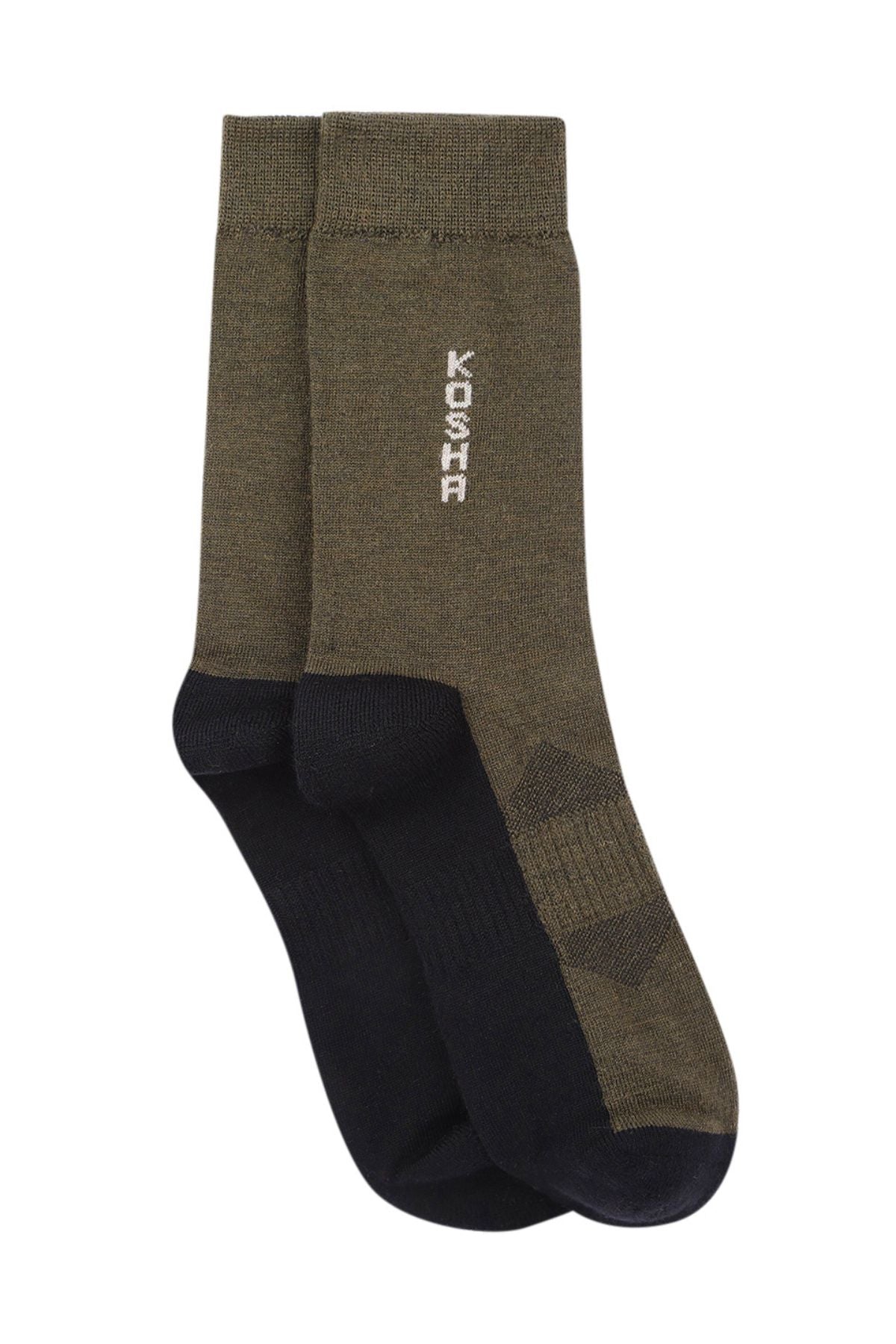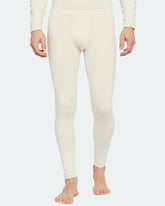Merino Wool Socks vs Cotton Socks: What To Choose for Winter Travel
Sock choice plays a crucial role in winter travel comfort. The wrong pair can lead to cold feet, discomfort, or blisters, making material selection essential. Merino wool socks provide warmth, breathability, and moisture control, ensuring cozy feet whether you're sightseeing or trekking in cold weather.
When you’re traveling in winter, your socks act as the foundation of your comfort. If you’re not wearing socks that keep your feet dry and warm, the cold can quickly take away the enjoyment of your trip. Merino wool and cotton are two popular materials used for winter socks, but they each have unique properties that suit different activities and climates. Understanding the differences can help you make an informed decision for your specific travel needs.
Merino Wool vs Cotton Socks: Key Differences You Should Know

Green and black socks with the brand "KOSHA" embroidered in white.
Now let's compare the 2 and see how different they are based on the different factors. This difference table will give you a proper comparison and difference between the two and which one is better, based on your preference.
|
Factor |
Merino Wool Socks |
Cotton Socks |
|
Warmth & Insulation |
Merino wool provides excellent insulation, even when wet, making it perfect for cold weather. It traps heat while allowing moisture to escape. |
Cotton socks tend to absorb moisture, which can leave your feet cold and damp in winter conditions, reducing insulation. |
|
Moisture Wicking |
Merino wool naturally wicks moisture away from the skin, keeping feet dry and reducing the risk of blisters. |
Cotton absorbs moisture, which can lead to soggy feet and increase the risk of blisters, especially during extended wear. |
|
Odor Resistance |
Merino wool has natural antimicrobial properties that reduce odors, allowing you to wear them for longer without washing. |
Cotton socks tend to hold onto moisture, which can lead to unpleasant odors after extended use. |
|
Breathability |
Merino wool is breathable and regulates temperature well, keeping feet warm without overheating. |
Cotton socks do not regulate temperature as effectively, and they may cause overheating during physical activity. |
Choosing the Best Socks for Winter Travel: What factors to Consider
When selecting the best Woolen socks in India for Women for winter travel, it’s essential to consider factors like material, fit, cushioning, and durability to ensure your feet stay warm, dry, and comfortable throughout your journey.
Material Composition
The material of the sock plays a huge role in warmth and comfort. Merino wool is often recommended for winter travel because it’s insulating, moisture-wicking, and naturally odor-resistant. Cotton, on the other hand, should be avoided in colder conditions as it traps moisture and can cause your feet to get cold and damp.
Thickness and Cushioning
Consider the thickness and level of cushioning you need for your activities. Thicker Men's Woolen Socks in India provide more warmth and support for trekking or colder environments, while thinner, lighter socks are ideal for indoor settings or less demanding activities. Pairing them with a Girl Merino Wool Cap ensures full protection from the cold, keeping your head warm while maintaining breathability and comfort.
Moisture-Wicking Properties
Winter travel often involves changes in temperatures and physical activity. Look for socks with excellent moisture-wicking properties to keep your feet dry and reduce the risk of blisters. Merino wool and synthetic blends are great at keeping feet dry even in cold conditions.

A cozy picnic scene featuring black and orange socks, apples, and a woven basket on a blanket.
Fit and Comfort
Make sure the socks fit snugly but aren’t too tight. A proper fit prevents rubbing and blistering, especially during long walks or hikes. Compression socks can offer extra support and circulation, particularly on long travel days or at high altitudes. Pair them with Boys Merino Wool Knitted Mittens to ensure warmth and protection in colder conditions while maintaining flexibility for outdoor activities.
Durability and Longevity
Durable socks are essential for winter travel, especially if you’ll be hiking or trekking. Look for socks with reinforced heels and toes to prevent wear and tear. Merino wool tends to be more durable than cotton, but consider synthetic options if you need something that’s easier to care for.
Thermal Socks for Cold Weather: Is Merino Wool the Ultimate Solution?
When it comes to thermal socks for cold weather, Merino wool is a standout due to its excellent insulation properties. The natural fibers trap air within the fabric, which helps to maintain warmth even in freezing temperatures. This ability makes Merino wool socks a perfect choice for winter adventures.
Unlike synthetic materials, Merino wool regulates body temperature efficiently. It not only keeps you warm when it’s cold but also allows breathability, preventing overheating during physical activities. This balance of warmth and airflow is crucial for comfort in varying weather conditions.

One of the biggest advantages of Merino wool is its moisture-wicking ability. It pulls moisture away from your skin, keeping your feet dry even in wet conditions. This is essential for maintaining warmth, as damp socks can make you feel much colder and increase the risk of frostbite. Winter trekking socks made from Merino wool enhance this protection, providing superior insulation and breathability to keep your feet warm and comfortable on demanding trails.
Merino wool socks are also known for their odor resistance. The fibers naturally prevent bacterial growth, which is the main cause of unpleasant odors. This makes them ideal for multi-day trips, as you won’t need to worry about your socks smelling after long hours of use.
In addition to being functional, Merino wool socks are incredibly comfortable. Unlike traditional wool, Merino wool is soft and itch-free, ensuring that your feet stay comfortable for long periods. The softness makes them ideal for travelers who need to wear their socks all day without discomfort.
Finally, Merino wool is highly durable and resilient. Despite being soft, it can withstand the wear and tear of outdoor activities, including hiking, trekking, or skiing. This makes Merino wool socks an excellent long-term investment for cold weather travel and adventures.
Cotton vs Wool Socks: Which Type Provides the Best Protection?
When it comes to winter trekking, having the right socks is crucial for foot protection. Trekking socks made from Merino wool are often considered the best choice because they offer warmth, moisture-wicking, and breathability, all of which are essential for long hikes in cold weather.
Cotton socks, on the other hand, are not suitable for winter trekking. Cotton retains moisture and can make your feet cold and uncomfortable, especially during a trek. Wet feet increase the risk of frostbite, making cotton socks less ideal for winter adventures.

A cozy workspace scene with pastel socks, a notebook reading "Don't be busy, be productive," and a camera.
Merino wool trekking socks provide additional cushioning, protecting your feet from blisters and soreness. The wool’s natural elasticity ensures a snug fit, reducing friction between your skin and the sock, essential for rigorous trekking. Woolen Socks for Men offer enhanced warmth and durability, making them the perfect companion for outdoor adventures in colder climates.
Lastly, synthetic socks, though good for short durations, may lack the same level of comfort and insulation as Merino wool. While they are lighter and dry quicker, they do not offer the same level of warmth and protection in extreme cold weather, making Merino wool the superior choice for winter trekking.
Final Verdict: Which Socks Are Truly Best for Your Winter Journey?
In conclusion, choosing the right winter socks is key to ensuring comfort and protection during your cold weather adventures. While Merino wool socks lead the pack with their warmth, moisture-wicking properties, and comfort, they are particularly essential for trekking in freezing conditions.
If you're looking for high-quality winter socks designed to withstand harsh conditions, consider exploring Kosha's range of Merino wool socks for travel and trekking. Designed with your comfort in mind, these socks offer the perfect blend of warmth and durability, making them the ultimate choice for your winter adventures. Chat on WhatsApp with our expert and get a detailed consultation on what to pack.
FAQs
Q1. Can Merino wool socks cause itching or discomfort?
Ans: Not usually. Merino wool is soft and fine, making it much gentler on skin compared to regular wool.
Q2. Are Merino wool socks worth the higher price for travel?
Ans: Yes, they offer better insulation, moisture-wicking, and odor resistance, making them a valuable travel investment.
Q3. Which is more eco-friendly, Merino wool or cotton?
Ans: Merino wool is natural and biodegradable, while cotton requires more water and chemicals to produce.





